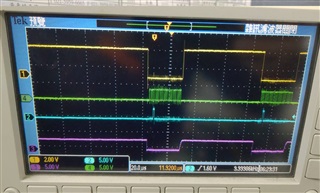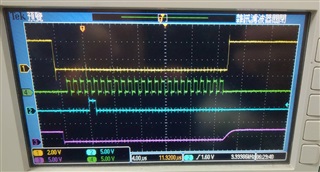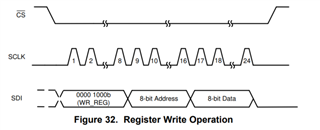Other Parts Discussed in Thread: ADS7038Q1EVM-PDK
Hi,
I attempt to control ADS7028 via TMS320C2000 Experiment Kit(Piccolo F28069).
My final purpose is get 2 RMS value and 2 ZCD signal from 2 Sine wave signal input. (Is this achievable?)
So far I have successfully send 24bit SPI frame from Experiment Kit.

Then, I tried to test read and write command of ADS7028, but it seems not respond at all.
(Write test: Set all channel to GPIO output and set logic 1 , Read test: read several registers ).
Is there any setting of SPI or my process is wrong?
_interrupt void cpu_timer1_isr(void){ // 100us loop
if(SPI_STATE==0){
SpiaRegs.SPITXBUF=0x1000;
SpiaRegs.SPITXBUF=0x2100;
SpiaRegs.SPITXBUF=0x0000;
SPI_STATE=1;
}else if(SPI_STATE==1){
SpiaRegs.SPITXBUF=0x1000;
SpiaRegs.SPITXBUF=0x2100;
SpiaRegs.SPITXBUF=0x0000;
SPI_STATE=0;
}
if(SpiaRegs.SPIFFRX.bit.RXFFST!=0) Result= SpiaRegs.SPIRXBUF;
}
void SPI_Init(){
SpiaRegs.SPICCR.all =0x07; // 8-bit char bits
SpiaRegs.SPICTL.all =0x06; // Enable master mode, normal phase, enable talk, and SPI int disabled.
SpiaRegs.SPIBRR = 0x0016; // BAUD= LSPCLK/(SPIBRR+1)= SPIBRR=(LSPCLK/BAUD)-1
SpiaRegs.SPICCR.all =0x87; // Relinquish SPI from Reset
SpiaRegs.SPIPRI.bit.FREE = 1; // Set so breakpoints don't disturb xmission
}
void SPI_FIFO_Init(){
SpiaRegs.SPIFFTX.all=0xE040;
SpiaRegs.SPIFFRX.all=0x2044;
SpiaRegs.SPIFFCT.all=0x0;
SpiaRegs.SPITXBUF=0x0800;
SpiaRegs.SPITXBUF=0x0500;
SpiaRegs.SPITXBUF=0xFF00;
while(Inter<1000000)Inter++;
Inter=0;
SpiaRegs.SPITXBUF=0x0800;
SpiaRegs.SPITXBUF=0x0700;
SpiaRegs.SPITXBUF=0xFF00;
while(Inter<1000000)Inter++;
Inter=0;
SpiaRegs.SPITXBUF=0x0800;
SpiaRegs.SPITXBUF=0x0900;
SpiaRegs.SPITXBUF=0xFF00;
while(Inter<1000000)Inter++;
Inter=0;
SpiaRegs.SPITXBUF=0x0800;
SpiaRegs.SPITXBUF=0x0B00;
SpiaRegs.SPITXBUF=0xFF00;
while(Inter<1000000)Inter++;
Inter=0;
}





 i
i 




